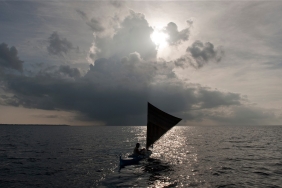GETTING TO KNOW SARANO WALI, THE WAKATOBI CUSTOMARY SYSTEM (3)
Authors: Rinto Andhi (Social Development Coordinator) and Sadar (Marine Conservation Outreach and Awareness Officer), WWF-Indonesia Program Southern Eastern Sulawesi Subseascape/SESS
Kaombo is a natural resource governance system in the Sarano Wali region. Kaombo applies to the conservation of natural resources and the biota that live within them, including protected forests, mangroves, coastal areas and coral reefs.
Indicators of Kaombo Still Effective and Running
There are seven indicators in assessing the institutionalization of kaombo, namely:
- Regional Boundaries
Kaombo has clear territorial boundaries with the boundaries of the kaombo used are the village administrative boundaries and ecological niche boundaries. Within the kaombo there are rope boundaries to the south and north as well as coral boundaries to limit the kaombo from the shoreline to the deep sea. bulugo moriri (yellow stone/rock). The length of the southern and northern ends is more than a kilometer with the boundary using a rope.
The rules of kaombo for users include only passing through (entrance right) (no taking). Kaombo is shifting of territorializing which means the location of kaombo can move. Initially kaombo was the entire coastal settlement of the village, but now only certain locations . The purpose of moving the location of kaombo is coral restoration with open and closed harvesting patterns.
- Rules
Sarano Wali's customary rules are absolute with the principle that the rules implemented are ritualized proof of grandchildren of the sky, namarika-namarisa. The rules are made and agreed upon with the approach of rembug adat (deliberation) of the entire community. Sarano Wali rules are an oral tradition and there has been no formal legal codification as a form of recognition from the government, either the Wakatobi National Park Office or the Wakatobi Regional Government.
In the rules of kaombo,there are rules of the game agreed upon by all Wali residents, namely:
- No management including mooring the boat;
- There are kaombo rules, namely bukaano kaombo (kaombo opened) and toomboemo (kaombo closed);
- Criteria for creating a kaombo region are as follows:
- Location of kaombo, agreed upon by the community (Wali Village residents) through deliberation;
- When the kaombo is open, its utilization is intended for the entire community in Kelurahan Wali;
- There is a pamali rule that during harvest time, people should not bring pots (according to the belief that bringing pots to fish can cause fortune in the sea to run out);
- There are rules of fishing gear that are allowed to catch fish, namely: kadhepe (female fishing gear), kulu-kulu, and kabau-bau.
- Fishing tools must not be small-eyed nets (minimum three inches mesize);
- Menstruating women are not allowed to catch fish because it will reduce fortune;
- In the process of opening and closing the kaombo, prayers are recited led by the kasisi of the mosque or the village imam;
- The information pattern that kaombo is an oral tradition (culadha tape-tape), stories passed down from their ancestors.
In addition to regulating area-based resources, kaombo also regulates resources based on types that have ecological, social, and economic functions, such as mangroves (or mangge-mangge in the local language), betanggor/dongkala- a type of wood that grows in swampy areas, dugong/dhiu, dolphins, sea gulls/manu-manu tambolo, rock clams/fangaro, penyu/ponu, etc.
- Hak
The entire Kelurahan Wali community has rights over the kaombo. The Wali community has the right to determine whether the combo is closed and open. Community rights also relate to using and prohibiting other users from entering or utilizing the combo. For a private combo, rights are attached to individual ownership. As for the public ones, the community is required to abide by the customary rules on coastal combo and has the right to prohibit and utilize when the combo is open.
Within the Wali community there are two layers of social structure: the customary (lakina), religious (imam) and government (lurah) leadership structures and the general community structure. It is this social structure that determines the scope of rights held by each entity in relation to kaombo.
(continued)





